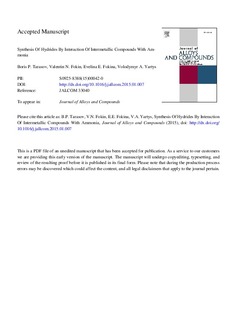| dc.contributor.author | Tarasov, Boris P. | |
| dc.contributor.author | Fokin, Valentin N | |
| dc.contributor.author | Fokina, Evelina E | |
| dc.contributor.author | Yartys, Volodymyr | |
| dc.date.accessioned | 2017-09-27T06:21:55Z | |
| dc.date.available | 2017-09-27T06:21:55Z | |
| dc.date.created | 2015-09-17T08:09:27Z | |
| dc.date.issued | 2015 | |
| dc.identifier.citation | Journal of Alloys and Compounds. 2015, 645 (1), S261-S266. | nb_NO |
| dc.identifier.issn | 0925-8388 | |
| dc.identifier.uri | http://hdl.handle.net/11250/2456916 | |
| dc.description.abstract | Interaction of intermetallic compounds with ammonia was studied as a processing route to synthesize hydrides and hydridonitrides of intermetallic compounds having various stoichiometries and types of crystal structures, including A2B, AB, AB2, AB5 and A2B17 (A = Mg, Ti, Zr, Sc, Nd, Sm; B = transition metals, including Fe, Co, Ni, Ti and nontransitition elements, Al and B). In presence of NH4Cl used as an activator of the reaction between ammonia and intermetallic alloys, their interaction proceeds at rather mild P-T conditions, at temperatures 100–200 ºC and at pressures of 0.6–0.8 MPa. The mechanism of interaction of the alloys with ammonia appears to be temperature-dependent and, following a rise of the interaction temperature, it leads to the formation of interstitial hydrides; interstitial hydridonitrides; disproportionation products (binary hydride; new intermetallic hydrides and binary nitrides) or new metal-nitrogen-hydrogen compounds like magnesium amide Mg(NH2)2. The interaction results in the synthesis of the nanopowders where hydrogen and nitrogen atoms become incorporated into the crystal lattices of the intermetallic alloys. The nitrogenated materials have the smallest particle size, down to 40 nm, and a specific surface area close to 20 m2 /g. | nb_NO |
| dc.language.iso | eng | nb_NO |
| dc.publisher | Elsevier | nb_NO |
| dc.rights | Attribution-NonCommercial-NoDerivatives 4.0 Internasjonal | * |
| dc.rights.uri | http://creativecommons.org/licenses/by-nc-nd/4.0/deed.no | * |
| dc.title | Synthesis of hydrides by interaction of intermetallic compounds with ammonia | nb_NO |
| dc.type | Journal article | nb_NO |
| dc.type | Peer reviewed | nb_NO |
| dc.description.version | acceptedVersion | nb_NO |
| dc.source.pagenumber | S261-S266 | nb_NO |
| dc.source.volume | 645 | nb_NO |
| dc.source.journal | Journal of Alloys and Compounds | nb_NO |
| dc.source.issue | 1 | nb_NO |
| dc.identifier.doi | 10.1016/j.jallcom.2015.01.007 | |
| dc.identifier.cristin | 1264865 | |
| dc.relation.project | Norges forskningsråd: 241352 | nb_NO |
| dc.description.localcode | © 2015. This is the authors’ accepted and refereed manuscript to the article. This manuscript version is made available under the CC-BY-NC-ND 4.0 license http://creativecommons.org/licenses/by-nc-nd/4.0/ | nb_NO |
| cristin.unitcode | 194,66,35,0 | |
| cristin.unitname | Institutt for materialteknologi | |
| cristin.ispublished | true | |
| cristin.fulltext | postprint | |
| cristin.qualitycode | 1 | |

